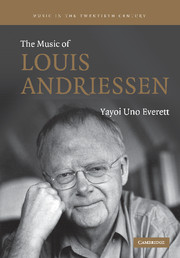Book contents
- Frontmatter
- Contents
- List of music examples and figures
- Acknowledgements
- List of abbreviations
- Introduction
- 1 Dutch music in the twentieth century
- 2 Formative years
- 3 Politics and “concept” works
- 4 Toward the metaphysical in art (1981–88)
- 5 Ramifications
- 6 Operatic collaboration with Peter Greenaway
- 7 Contemplative works
- 8 Epilogue
- Bibliography
- Index
4 - Toward the metaphysical in art (1981–88)
Published online by Cambridge University Press: 22 September 2009
- Frontmatter
- Contents
- List of music examples and figures
- Acknowledgements
- List of abbreviations
- Introduction
- 1 Dutch music in the twentieth century
- 2 Formative years
- 3 Politics and “concept” works
- 4 Toward the metaphysical in art (1981–88)
- 5 Ramifications
- 6 Operatic collaboration with Peter Greenaway
- 7 Contemplative works
- 8 Epilogue
- Bibliography
- Index
Summary
Andriessen chooses his own labyrinth in musical history and himself as its center. Each journey through it is made with the future as the point of departure and the finishing point. That is why in his music the distinction between allusion, quotation, and own music is ultimately unimportant. The result is always music with an inalienable individual identity, intractable and direct, compelling and detached.
(Schönberger 2001a: 637)During the 1980s, Andriessen's aesthetic focus gravitated away from the raucous and polemical works of the preceding decade to the exploration of philosophical and conceptual themes in increasingly abstract terms. De Tijd (1980–81) and De Snelheid (1982–83) are “concept” works that display constructivist rigor, in which explicit quotations and allusions to historical styles are conspicuously absent. These compositions nonetheless grapple with a metaphysical principle (e.g., perception of time or velocity) in compelling ways.
During the same period Andriessen embarked on a large-scale theatrical production of De Materie (1985–88) on the subject of philosophers, scientists, and artists from diverse periods of European (primarily Dutch) history. The composer found in Robert Wilson's ritualized, non-narrative approach to theater an ideal counterpart to his music. Through the iconic transference of proportions derived from musical, architectural, visual, and literary sources, Andriessen constructs the musical form of the four movements in De Materie as an analogue to J. S. Bach's Prelude (Part I), the plan of Rheims Cathedral (Part II), Mondrian's abstract painting (Part III), or the structure of Willem Kloos's sonnet (Part IV).
- Type
- Chapter
- Information
- The Music of Louis Andriessen , pp. 100 - 143Publisher: Cambridge University PressPrint publication year: 2007



